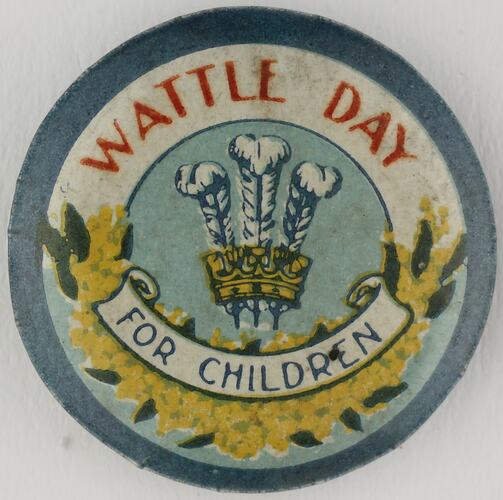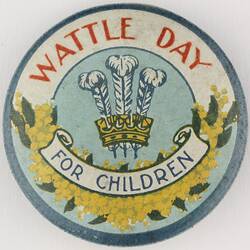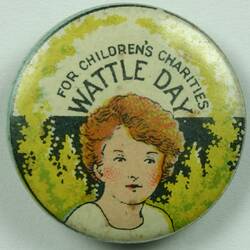Summary
Alternative Name(s): Button
'Wattle Day for Children' badge, made circa 1914-1919. Badge intended to be pinned to clothing.
The first 'national' Wattle Day was celebrated in Sydney, Melbourne and Adelaide on 1 September 1910. Wattle had become a symbol of Australia with the approach of Federation. It was particularly promoted by the Australian Natives' Association, established in Melbourne in 1871 as a non-partisan and non-sectarian friendly society for Australian-born, white men seeking to shape Australia's nationhood and identity. The ANA was a strong advocate for Federation and became an advocate for White Australia. It was a staunch supporter of trade protection and immigration restriction, and Prime Minister Alfred Deakin was a member. Public support for Wattle Day peaked during World War I, when it was a potent symbol of home for military personnel serving overseas, and a means of raising money for organisations such as the Red Cross. Beautifully designed Wattle Day badges as well as wattle sprigs were sold. The influence of Wattle Day waned as the 20th century progressed, but in 1992 the Governor-General declared 1 September National Wattle Day.
Physical Description
Round metal badge with blue outer border. Words printed in red on outer border and in blue in banner below central image of a yellow crown with three feather pen quills behind it (Prince of Wales' feathers - heraldic symbol). The lower banner is in front of a wreath of wattle blossom. Maker printed on outer lower rim edge. Metal pin in back fits in slot.
More Information
-
Collecting Areas
-
Acquisition Information
Donation from Mr H. Legge, 14 Feb 1989
-
Manufacturer
A.W. Patrick, Australia, 1914-1918
The donor believed this badge to date to World War I. -
Inscriptions
Outer border: "WATTLE DAY" Lower banner: " FOR CHILDREN" On lower outer rim: "A W PATRICK 440 RAE ST N FITZROY VIC".
-
Classification
-
Category
-
Discipline
-
Type of item
-
overall dimensions
4 mm (Height), 23 mm (Outside Diameter)
-
Keywords
Community Organisations, Fundraising, Wars & Conflicts, Wattle Day, World War I, 1914-1918



